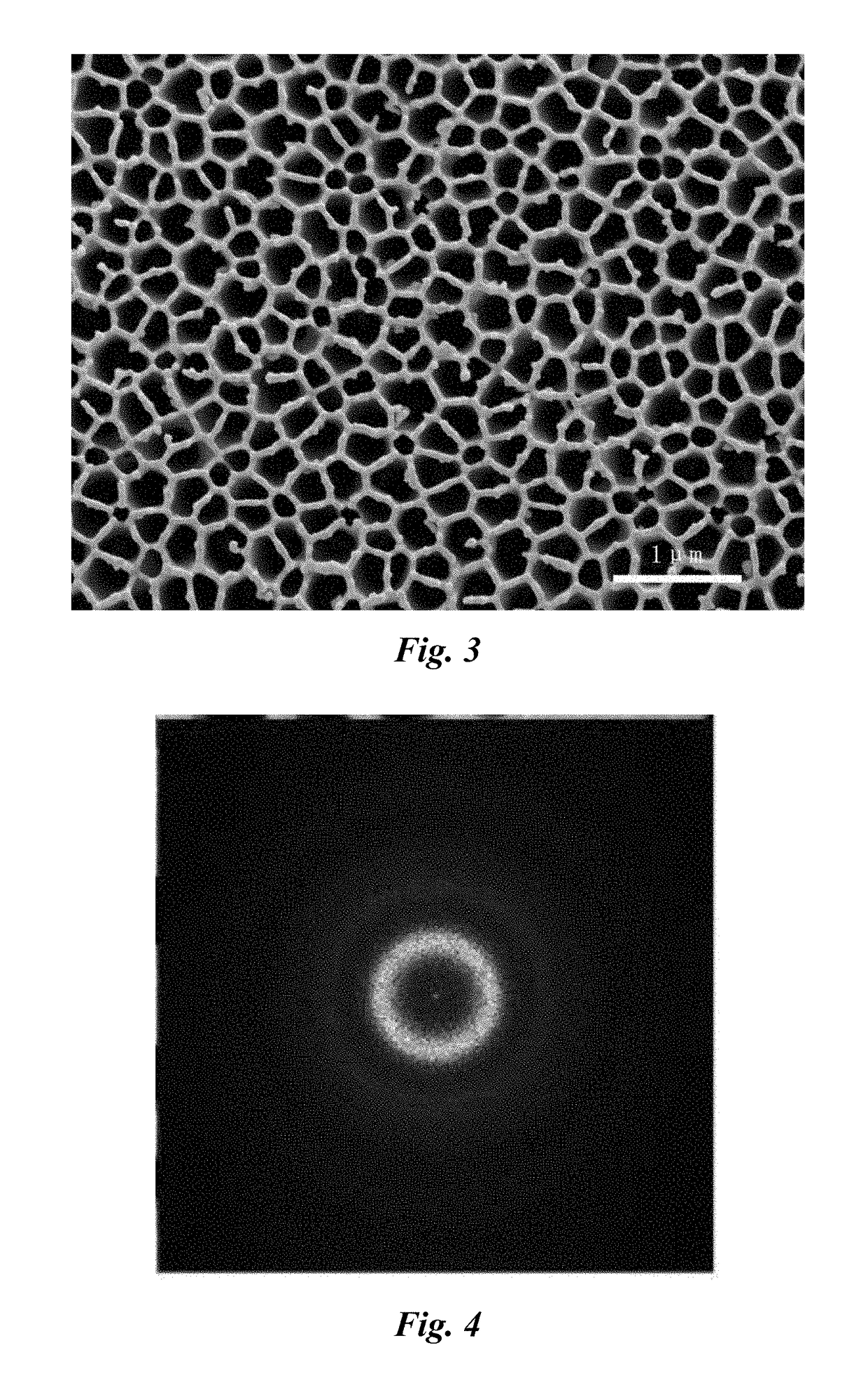Composite material device
- Summary
- Abstract
- Description
- Claims
- Application Information
AI Technical Summary
Benefits of technology
Problems solved by technology
Method used
Image
Examples
example 1
[0145]Step 1: Porous anodic alumina templates (hereafter abbreviated as NPT) were manufactured by a two-step anodic oxidation method. The method comprised the following steps: an aluminum foil was placed in 0.3 M phosphoric acid at 5° C. for the anodic oxidation; the oxidation voltage, starting from 50 V, was increased by 10 V in every 2 minutes, until it reached 150 V, and the voltage was kept for 24 hours, thereby to finish the first oxidation; thereafter, the alumina film formed in the first oxidation was removed by dissolving it, and under the same conditions as those of the first oxidation, the second oxidation was performed; after the second oxidation, the aluminum foil coated with a porous aluminum film was placed in a mixture liquid containing 1 M CuCl2 and 0.1 M HCl to remove the aluminum substrate by dissolution; at last, the porous aluminum film was transferred into 5 wt % H3PO4, to expand pores at 30° C. for about 1 h, thereby to produce the NPT of Example 1.
[0146]FIG. 1...
example 2
[0153](1) A NPT was produced by using the method in Example 1.
[0154](2) Gold (Au) is deposited both on the disordered surface of the NPT and on the inner walls of the pores on the disordered surface by using an ion beam film plating meter Gatan Model 682, in particular, the vacuum degree being 5×10−4 Pa, the electron gun voltage being 7 KeV, the electric current being 300 uA, and the depositing time being 16 min. The resultant product was the composite material device of Example 2 (hereafter abbreviated as Au / D-NPT).
[0155]Au / D-NPT comprised a NPT and gold particles adhered onto the inner walls of the pores of the NPT. The gold particles were disposed at a position from 0 to 2 μm in depth from the disordered surface of the NPT to the interior. Au / D-NPT further comprised a gold layer covered on the disordered surface of the NPT, and the gold layer only cover the regions without pores on the disordered surface. The thickness of the gold layer was from about 60 to 90 nm, and the thickne...
example 3
[0171]Step 1: A method for producing NPT having an average pore diameter of about 200 nm is described as follows:
[0172]Porous anodic alumina templates (hereafter abbreviated as NPT) was fabricated by a two-step anodic oxidation method. The method comprises the following steps: an aluminum foil was placed in 0.5 M phosphoric acid at 5° C. for anodic oxidation; the voltage of anodic oxidation started from 50 V, increased by 10 V in every 2 minutes, until it reached 150 V, and the voltage was kept for 24 hours, thereby to finish the first oxidation; thereafter, the alumina film formed in the first oxidation was dissolution removed, and under the same conditions as those of the first oxidation, the second oxidation was performed; after the second oxidation, the aluminum foil coated with a porous aluminum film was placed in a mixture liquid of 1 M CuCl2 and 0.1 M HCl to remove the aluminum substrate by dissolution; at last, the porous aluminum film was transferred into 5 wt % H3PO4, to e...
PUM
| Property | Measurement | Unit |
|---|---|---|
| Length | aaaaa | aaaaa |
| Fraction | aaaaa | aaaaa |
| Fraction | aaaaa | aaaaa |
Abstract
Description
Claims
Application Information
 Login to View More
Login to View More - R&D
- Intellectual Property
- Life Sciences
- Materials
- Tech Scout
- Unparalleled Data Quality
- Higher Quality Content
- 60% Fewer Hallucinations
Browse by: Latest US Patents, China's latest patents, Technical Efficacy Thesaurus, Application Domain, Technology Topic, Popular Technical Reports.
© 2025 PatSnap. All rights reserved.Legal|Privacy policy|Modern Slavery Act Transparency Statement|Sitemap|About US| Contact US: help@patsnap.com



